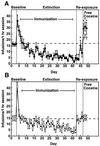Cocaine vaccines: antibody protection against relapse in a rat model
- PMID: 10823960
- PMCID: PMC18582
- DOI: 10.1073/pnas.97.11.6202
Cocaine vaccines: antibody protection against relapse in a rat model
Abstract
The efficacy of active immunization with the cocaine immunogen GNC-keyhole limpet hemocyanin (KLH) in preventing cocaine self-administration reinstatement was assessed in rats. An animal model of relapse was used where rats were trained to self-administer cocaine, subjected to a period of extinction by substituting the drug for saline, vaccinated, and re-exposed to cocaine. Compared with controls, animals immunized with GNC-KLH did not reinstate cocaine self-administration behavior when given a noncontingent cocaine infusion on two consecutive days. Upon double and triple infusions, 38-62% of vaccinated animals failed to reinstate as compared with full reinstatement in all control animals. Exposure to ad libitum cocaine reinstated baseline values in control animals and resulted in double to triple the baseline values of self-infusions in vaccinated animals, suggesting a partial antibody-mediated blockade of cocaine access to the central nervous system. This compensating effect was blocked by passive immunization pretreatment with the monoclonal IgG GNC92H2 in both vaccinated and control groups. To further assess the surmountability potential of GNC-KLH-induced antibody titers by cocaine self-administration, and the capacity of these titers to block the reinforcing effects of the drug, rats were tested at various doses of cocaine (0.015-0.5 mg/infusion). Active immunization with GNC-KLH produced approximately an 8-fold rightward shift of the dose-effect function for cocaine. The results reported suggest that immunopharmacotherapy may offer a promising means to treat cocaine abuse by aiding in the prevention of relapse.
Figures





References
-
- National Institute on Drug Abuse. National Household Survey on Drug Abuse, Population Estimates (1995) Rockville, MD: U.S. Dept. of Health and Human Services; 1996.
-
- Cregler L L, Mark H. N Engl J Med. 1986;315:1495–1500. - PubMed
-
- Lee J H, Bennett G. In: Substance Abuse: Pharmacologic, Developmental and Clinical Perspectives. Bennett G, Wolf D, editors. New York: Delman; 1991. pp. 157–170.
-
- Carrol F I, Lewin A, Biswas J. Pharmacol News. 1994;1:11–16.
-
- Carrera M R A, Ashley J A, Parsons L H, Wirsching P, Koob G F, Janda K D. Nature (London) 1995;378:727–730. - PubMed
Publication types
MeSH terms
Substances
Grants and funding
LinkOut - more resources
Full Text Sources
Other Literature Sources
Medical
Research Materials

